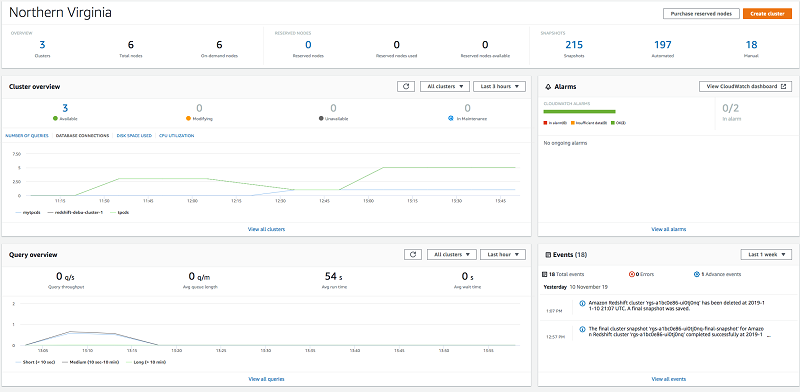Amazon Redshift
About Amazon Redshift
Amazon Redshift Pricing
Please contact Amazon Web Services for pricing details.
Free trial:
Not Available
Free version:
Not Available

Other Top Recommended Business Intelligence Tools
Most Helpful Reviews for Amazon Redshift
1 - 5 of 14 Reviews
Yanick
Verified reviewer
Food & Beverages, 2-10 employees
Used daily for less than 2 years
OVERALL RATING:
5
EASE OF USE
4
VALUE FOR MONEY
4
CUSTOMER SUPPORT
4
FUNCTIONALITY
5
Reviewed June 2022
Best Selection...
What's special about Amazon Redshift is that it constantly offers new features to meet the demands of increasingly large data stores. It is undoubtedly the best solution for data storage and processing in the cloud. If you are not yet a user, I highly recommend it.
CONSIt takes time to get up to speed with all the features of Amazon Redshift.
Anonymous
201-500 employees
Used daily for more than 2 years
OVERALL RATING:
4
EASE OF USE
4
VALUE FOR MONEY
4
FUNCTIONALITY
4
Reviewed April 2022
Reliable and easy to set up
Redshift has given us a viable OLAP data warehouse which speeds up all of our analytical workloads. The main benefits we got are speed, ease of use, and reliability, which in turn gave us more time to work on other projects and also much better visibility of our products and business.
PROSRedshift is a reliable cloud data warehouse that's easy to set up especially if your tech infra already runs on AWS.
CONSScaling out/up/down is quite limited with Redshift. The elastic resize is supposed to help on this but it's still limited to just halving/doubling your current cluster. It's not as flexible as Snowflake or BigQuery. Also, the max concurrency of 50 is quite low compared to other cloud data warehouses.
Reason for choosing Amazon Redshift
Redshift's pricing is straightforward and more predictable compared to other cloud data warehouses. Also, our existing tech infrastructure already runs on AWS so using Redshift gave us much better integration with our current tech stack.
Reasons for switching to Amazon Redshift
Our datasets are getting larger and larger. We needed an OLAP database which was more appropriate for our reporting and analytics workloads.
Gordon
Health, Wellness and Fitness, 201-500 employees
Used daily for more than 2 years
OVERALL RATING:
3
EASE OF USE
5
VALUE FOR MONEY
3
CUSTOMER SUPPORT
4
FUNCTIONALITY
3
Reviewed March 2024
Amazon Redshift - Average product
In my Opinion AWS redshift is an average product, the syntax and methods you have to use if you are used to using SQL server you will find to be more long winded or searching for alternatives ways. Basic items like parameters in stored procedures after a lot more complex than required.
PROSIt is a good tool for combining multiple data sources into one place. It is not really useful to load data in a delta approach but to fully reload the data source.
CONSIts ETL process always wants you to create objects as S3 objects which most of the time is fine but you then end up storing the data twice, once in the 3s and then again in Redshift unless you code to delete the S3 files after loading.
Craig
Verified reviewer
Marketing and Advertising, 1,001-5,000 employees
Used daily for less than 2 years
OVERALL RATING:
5
EASE OF USE
5
VALUE FOR MONEY
4
FUNCTIONALITY
5
Reviewed May 2022
Solid, Reliable Option for Warehouse Storage
Redshift is the bedrock upon which our entire product lives. It stores the underlying data for our reporting, dashboards, etc.
PROSRedshift is a great starting point for storing data if you're planning to build out a stack using other AWS products (EMR clusters, S3 for browsing, etc.). Redshift is reliable/dependable, we haven't faced uptime issues or anything like that. Easy to query against which is essential for us when pulling reports or performing QA. In previous work I've also been able to hook Redshift up directly to Tableau which has been huge in building ad-hoc reporting directly from our datastore.
CONSIntegrations aren't always as intuitive as with other tools, but this can be avoided with a solid internal knowledge base.
Filippo
Verified reviewer
Marketing and Advertising, 51-200 employees
Used weekly for more than 2 years
OVERALL RATING:
5
EASE OF USE
5
VALUE FOR MONEY
5
CUSTOMER SUPPORT
4
FUNCTIONALITY
5
Reviewed October 2023
A must-have tool for data warehousing
Amazon Redshift helped us creating standard reports for advertising activities and proved to be a valuable data source for our visual dahsboards
PROSAmazon Redshift allowed us to organize efficiently all our data, both for reporting and visualization purposes. You can use SQL syntax to query the tables and to extract all the info you need. It supports multiple datatypes with many data compression solutions to save disk space and money. The Amazon Redshift console (on the AWS dashboard) allows you to keep track of your db performances, from query execution time to disk space used, and displays also wise recommendation on how to manage properly your tables.
CONSThere is nothing I can complain about Amazon Redshift.




